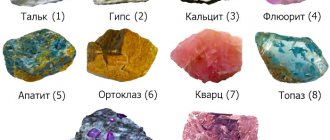The history of the Mohs scale
The creator of the system for determining the hardness of minerals is the German scientist Karl Friedrich Christian Moos. From a young age he studied physics, chemistry and mathematics, and after graduating from university he worked in a mine. In 1802, Moos moved to Austria and began work on systematizing the collection of minerals of one of the major businessmen. After 10 years, the scientist was invited to the city of Graz, where he participated in the creation of a scientific academy known as the University of Graz.
Among Mohs's many scientific achievements, the most famous is the creation in 1811 of a scale of mechanical hardness of stones. This was a remarkable solution at the time, since minerals were classified solely by their chemical composition. Mohs proposed a convenient scale of 10 positions, in which the highest score was assigned to the hardest mineral, diamond, and the lowest to soft talc.
Between them are located 8 more reference rocks in increasing mechanical hardness:
- talc;
- gypsum;
- lime spar (calcite);
- fluorspar (fluorite);
- apatite;
- orthoclase;
- silicon dioxide – quartz;
- topaz;
- corundum;
- diamond.
Currently, there are 2 modifications of diamond that are superior in hardness: fullerite and lonsdaleite. But the Mohs scale is still relevant. The hardness of granite is about 6.5 points - average between apatite and orthoclase. For comparison, the characteristic of marble is only 3.5 points, which is comparable to the hardness of a copper coin. Stones of different colors can have different characteristics. For example, granites with a pink tint, which you can read about here, are slightly softer than hard rocks, so they are often used for decorative purposes.
Chemical composition
The unique properties of granite and its external characteristics make it possible to use the stone in various fields of activity, mainly in construction.
A complete description of granite is contained in many specialized books. The acidic igneous structure of the rock has a granular appearance. To a greater extent, the granite rock consists of feldspars, quartz, and mica. Its formula is CaCO3.
The properties of granite and its color are determined by the amount of spar and quartz. What color does the breed come in? Common shades are light gray, pink, yellow, red, green. Transparent inclusions of quartz give the rock hardness and glassiness. In nature there are rare varieties with blue splashes. They influence the overall shade of the stone and make it unique.
The crystal structure of granite stone is divided into:
- fine-grained - grain sizes less than 5 mm;
- medium-grained - up to 1 cm;
- coarse-grained - from 1 cm.
Most of the granite components are variegated in color. It is almost impossible to find identical shades in nature; they simply do not exist. Its external features depend on the deposit where granite is mined. Thus, the Karelian stone is red; in Sweden there is a rare amethyst variety.
Magic properties
Talismans and various decorations made of marble have undoubted healing properties, which were known in ancient times. The ability of the mineral to prevent the occurrence of various diseases and alleviate the condition of patients has been widely used in medicine. At the same time, we should not forget about another use of marble - instruments for massage procedures are made from it. Smooth stone balls, based on blue marble and rocks of other colors, are intended to affect the skin and muscles of those people who suffer from damage to the spinal cord roots (sciatica) and joint pain.
The inhabitants of Ancient Greece called marble nothing less than a real stone of love and took careful care of it. The Hellenes associated the mineral with Aphrodite (in Greek mythology, the goddess of beauty and love) and treated it with great respect. Many temples were built by the ancient Greeks from this material.
The inhabitants of Hellas firmly believed that marble amulets were capable of preserving love feelings in marriage, resisting jealousy, and helping in the birth of descendants, so they carried them with them and kept them in their homes.
The valuable breed, which has a special solemn beauty, was held in high esteem by the inhabitants of Ancient Rome. They tried to build houses from it, so the marble color was typical for buildings of that time. The Romans not only admired the magnificent appearance and reliability of the stone, but also hoped that it would protect their homes from evil spirits and various misfortunes.
In India, the material is still popular among local residents. It can be found in almost every home, regardless of who lives in it - a rich person or a poor person. Indians believe that the magical mineral helps people establish communication with good spirits. In their opinion, he is obliged to be present in the homes of those people who, due to their duties, spend a lot of time in society. They mean law enforcement officers, military personnel, customs officers, doctors, teachers, sellers and managers. The saving stone, residents of the exotic Asian country believe, can protect such people from various dangers and negative influences from the outside. He will help them in stabilizing their personal lives, searching for love and harmony.
Mystical healing stone
A stone of natural origin emits its own powerful energy, which people use for good. This applies to both the treatment of ailments and the impact on subtle planes.
Medicine has proven that marble has a beneficial effect on the human body:
- Improves the functioning of the heart muscles, as well as cardiovascular organs.
- Eliminates causeless anxiety, insomnia, and depression.
- Improves mood, raises body tone and stress resistance.
All kinds of talismans and amulets are made from marble. Its energy radiation protects from the evil eye, strengthens relationships in couples and attracts good people into life. And a woman who carries a marble amulet with her has a greater chance of conceiving a healthy baby.
Application of the mineral
The color of marble and the characteristics that are inherent in it allow this material to be used in a wide variety of fields. The plasticity of the rock and its ability to be easily processed make it suitable for the manufacture of decorative elements of buildings, architectural monuments, and tombstones in cemeteries. Stone is widely used in the process of both external and internal finishing of buildings, in particular, in the production of stair steps and railings, window sills, bathroom sinks, and fireplaces. Marble tiles serve as the basis for borders and paths.
Marble products not only look good, they are also environmentally safe, resistant to frequent temperature changes, durable and reliable. If they are cared for properly, things will delight their owners for many years, while maintaining their quality characteristics. Various jewelry made from this wonderful mineral in the form of bracelets, rings, beads, pendants, pendants and earrings are quite common.
The essence of the method and the searches of scientists
The principle of the method turned out to be simple: Mohs took plaster and could not scratch any other stone with it. He conditionally defined its hardness as 1.
He arranged the following . The last stone, number 10, was a diamond that could not be scratched by any other nugget.
For example, hardness is 7 if neither the gem under study nor the quartz damage each other.
Selected standards
The scientist chose 10 minerals , the correspondence to one of which is called hardness on the Mohs scale.
The table lists minerals - standards of hardness.
| Mineral | Properties | |
| 1 | Talc | It is easily scratched even with a fingernail and will not harm any mineral. The hardness of graphite is approximately the same, which is why a simple pencil is often used as a material at hand when checking. |
| 2 | Gypsum | It is damaged by the fingernail and leaves scratches on the talcum powder. |
| 3 | Calcite | Scratches the previous standard. |
| 4 | Fluorite | Damages the previous standard and is scratched by a knife. |
| 5 | Apatite | Glass hardness on the Mohs scale is 5.5. Consequently, a gem can also be damaged by glass by applying great force. |
| 6 | Orthoclase | It scratches the glass when pressed hard and is damaged by a steel file. |
| 7 | Quartz | Stronger than glass and softer than diamond. |
| 8 | Topaz | Durable mineral, scratches quartz, glass. Grinds with diamond-coated tools. |
| 9 | Corundum | Second only to diamond. |
| 10 | Diamond | Maximum hardness. |
Quantitative values
The Mohs scale is a reflection of the relative strength of stones. That is, if talc is in first place, and diamond is in 10th place, this does not mean that the difference between their hardness is a multiple of only 10.
In fact, diamond is 1500 times harder than talc. The absolute hardness of all nuggets is measured using special devices - sclerometers.
This is what the expanded table of minerals with absolute indicators looks like.
| Relative value | Mineral | Absolute value |
| 1 | Talc | 1 |
| 2 | Gypsum | 3 |
| 3 | Calcite | 9 |
| 4 | Fluorite | 21 |
| 5 | Apatite | 48 |
| 6 | Orthoclase | 72 |
| 7 | Quartz | 100 |
| 8 | Topaz | 200 |
| 9 | Corundum | 400 |
| 10 | Diamond | 1500 |
Apparent disadvantages
Despite the conventionality of the indicators, all attempts to refine the scale have not received recognition . It seemed wrong to scientists to take calcite as a standard due to the fact that its hardness varies. But the mineral galena, similar to it, also did not become ideal in this indicator.
Therefore, the only worldwide recognized system for classifying minerals by hardness remains the Mohs scale.
Scientific research
There are other classifications of minerals by hardness: Knoop, Brinell, Rockwell or Vickers . They are based on the stone’s resistance not to scratching, but to indentation.
The measurement is made using a special device that presses on the mineral with a given force. Using a formula, the strength is calculated based on the force and the corresponding depth of the hole. The devices differ from each other , so the numbers are different, making it impossible to compare the values of different methods.
Other scientists have come up with more technically complex calculation methods. Despite the accuracy of the indicators, most people understand and are more accustomed to comparing the hardness of stones on the Mohs scale .


